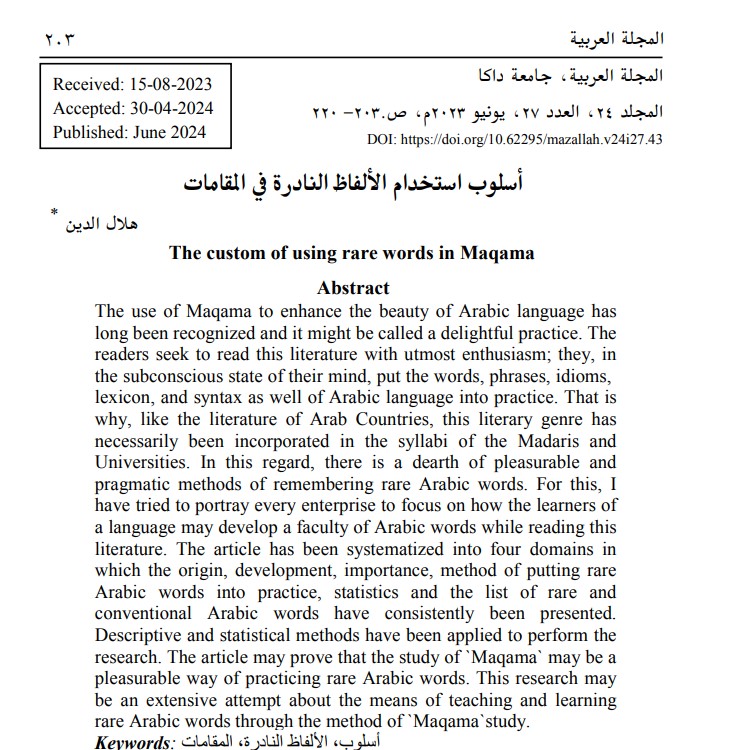The custom of using rare words in Maqama
DOI:
https://doi.org/10.62295/mazallah.v24i27.43Keywords:
أسلوب، الألفاظ النادرة، المقاماتAbstract
The use of Maqama to enhance the beauty of Arabic language has long been recognized and it might be called a delightful practice. The readers seek to read this literature with utmost enthusiasm; they, in the subconscious state of their mind, put the words, phrases, idioms, lexicon, and syntax as well of Arabic language into practice. That is why, like the literature of Arab Countries, this literary genre has necessarily been incorporated in the syllabi of the Madaris and Universities. In this regard, there is a dearth of pleasurable and pragmatic methods of remembering rare Arabic words. For this, I have tried to portray every enterprise to focus on how the learners of a language may develop a faculty of Arabic words while reading this literature. The article has been systematized into four domains in which the origin, development, importance, method of putting rare Arabic words into practice, statistics and the list of rare and conventional Arabic words have consistently been presented. Descriptive and statistical methods have been applied to perform the research. The article may prove that the study of `Maqama` may be a pleasurable way of practicing rare Arabic words. This research may be an extensive attempt about the means of teaching and learning rare Arabic words through the method of `Maqama`study.
References
ابن منظور، أبو الفضل جمال بن مكرم (د.ت). لسان العرب، د.ك، بيروت: دار صادر.
ضيف، شوقي. العصر العباسي الثاني، (1980) القاهرة: دار المعارف
الهمذاني، بديع الزمان أبو الفضل أحمد بن الحسين (د.ت). شرح مقامات بديع الزمان الهمذاني، تأليف محمد محي الدين عبد الحميد،ط2، بيروت: دار الكتب العلمية.
الهمذاني، بديع الزمان أبو الفضل أحمد بن الحسين (2005)، المقامات، تحقيق الشيخ محمد عبده،ط3، بيروت: دار الكتب العلمية.
مبارك، زكي (د.ت). النثر الفني في القرن الرابع، د.ط، القاهرة: مؤسسة هنداوي للتعليم والثقافة.
السعافين، أبرهيم (1987). أصول المقامات،ط1، دمشق:دار المناهل
الحريري، أبو محمد القاسم بن علي (1978). الديوان برواية، د.ط، بيروت: دار بيروت للطباعة والنشر.
سلام، محمد زغلول. 1412ق/1999م، الأدب في العصر العباسيين، ط1، الإسكندرية: منشأة المعارف.
عبد الحميد، محمد محي الدين، شرح مقامات بديع الزمان الهمذاني، دار الكتب العلمية، بيروت، د ت.
مرتاض، علد الملك، فن المقامات في الأدب العربي، الدار التونسية للنشر، ط2، تونس،1988.
محمد غنيمي هلال: النقد الأدبي الحديث، دار نهضة مصر، (د.ط)، القاهرة، مصر، 1997م.
السيوطي، جلال الدين عبد الرحمن، ط1، 1965م، بغية الوعاة في طبقات اللغويين والنحاة: تحقيق: محمد أبو الفضل إبراهيم، عيسى الحلبي.
عباس، حسن عبد العال، د.ت، نشأة المقامة في الأدب العربي، دار المعارف.
الحصري، زهر الآداب، 1/235، نقلا عن مصطفى الشكعة، بديع الزمان الهمذاني.
الشكعة، مصطفى، بديع الزمان الهمذاني.
الجنان، مأمون بن محي الدين، بديع الزمان الهمذاني بين المقالة والرسالة، دار الكتب العلمية، بيروت، لبنان، ط1، 1993م.
الفاخوري، حنا، تاريخ الأدب العربي، دار الكوثر، القاهرة، 2012م.
يوسف، نور عوض، فن المقامات بين المشرق والمغرب، ط1، دار القلم، بيروت، 1979م.
ضيف، شوقي، المقامة، ط3، دار المعارف، مصر، 1976م.
الهاشمي، السيد أحمد، جواهر الأدب في أدبيات وإنشاء لغة العرب، دار الفكر للطباعة والنشر، بيروت، لبنان، د.ط، ج1، ص: 223.
مرتاض، عبد المالك، المقامات في الأدب العربي.
Alfred Beeston, “The Genesis of the Maqamat Genre,” Journal of Arabic Literature, 1971, 1–12.


